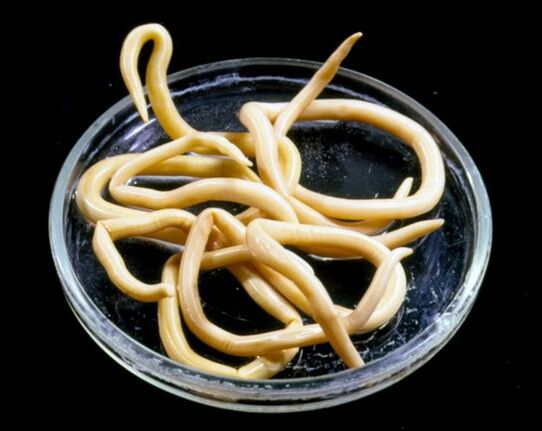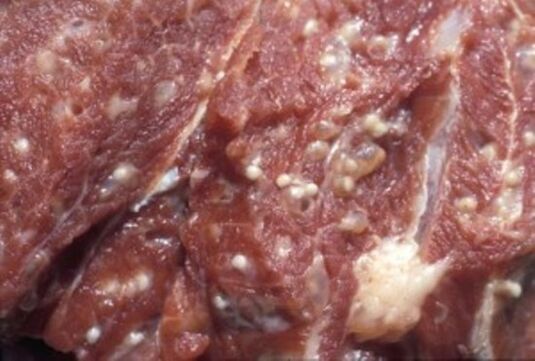The most common helminths are worms in humans. These parasites in the human body lead to many complications, including: disorders of the gastrointestinal tract, physical damage to internal organs, helminthiasis.
Helminthosis is not a disease, but a group of diseases caused by parasites that live in humans. All helminths are divided into 3 main types:
- nematodes (belonging to the order of nematodes), prominent representatives - nematodes, pinworms, whipworms;
- tapeworms, or tapeworms (a group of flatworms), represent tapeworms, beef tapeworms;
- flukes or trematodes (an order of flatworms) are liver flukes.
Since helminths leave the host during the breeding season to preserve the species, when moving to another vector or environment, they are also divided according to the type of transmission:
- Mechanical transmission involves traveling long distances, while the development of worms in the body of the carrier does not occur. This includes most of the arthropods (crustaceans, spiders and centipedes) that are often carried on the legs of the common fly.
- The intermediate host is a special mode of transmission in which one of the stages of development takes place in the host's organism. For example, for bovine tapeworm, cattle act as the vector (intermediate host) and humans as the final vector.
Helminths differ according to the mode of transmission:
- active (contact);
- passive (food).
Contact worms are able to penetrate the human body through the mucous membrane and skin (schistosomes, hookworms). Food products are more common, they develop in a person after consuming unwashed food, in contact with sick people or not following the rules of personal hygiene.
In total, there are more than 250 species of lower worms in the world that parasitize humans. Since the symptoms of the presence of worms in humans have different manifestations, therefore, at the slightest suspicion, you should contact a specialist and undergo an examination.
Life cycle of worms, their reproduction and development
An example of the development of helminths is the classic scheme of the life cycle of nematodes. Parasite eggs are extremely resistant to external harmful influences and can remain in the soil for up to six months.
The larval development itself lasts from 2 weeks to 2 months, depending on the environmental conditions: temperature, humidity, availability of oxygen. A ripe egg with food enters the stomach, where the gastric juices erode the eggshell, releasing the larva.

After that, the nematode enters the bloodstream through the intestinal wall and begins to move through the blood vessel system until it enters the alveoli of the lungs. The nematode larva is aerobic, only here it becomes active and continues to develop.
They feed on blood, grow up to 3-4 mm in length. Having reached primary maturity 4-5 days after invasion, the nematode begins to move into the bronchi.
Its movement causes a person to cough, as a result of which the larva, together with mucus, enters the oral cavity and returns to the intestines. This is where the final stage of larval formation in the adult takes place.
The life cycle of an adult nematode lasts about a year, during which time it lays up to 250, 000 eggs. Human health, and sometimes life, directly depends on the presence of worms in the body and their number, so it is important to start treatment as soon as possible.
Ascariasis is accompanied by intoxication, and intestinal obstruction will be a complication, which in some cases will require urgent surgical intervention.
Reproduction of helminths takes place in 2 ways by which helminths are divided into biohelminths and geohelminths. Usually the eggs of the parasite enter the external environment - here they mature. The egg must then enter the host, where it fully develops (geohelminths) or undergoes a stage of transformation into a larva (biohelminths).

In biohelminths, the development process is more complex, the stages of development in an adult individual and reaching maturity are separated from the stage of larva appearance. That is, from the external environment, the egg first enters the middle carrier, where the larva hatches.
Therefore, it needs to enter the body of the last host to reach the adult form. Sometimes biohelminths change up to 4 intermediate hosts before reaching the final host.
Symptoms
How to determine the presence of worms? Polymorphic symptoms and the absence of pain in the early stages of the disease make diagnosis difficult.
Often, the causes of the appearance of worms in humans are associated with the use of stale or contaminated food, and the parasites themselves live directly in the digestive tract, so the signs of their presence in the human body in most cases relate to the work of the intestines:
- liquid stool (unstable;
- pain and swelling;
- allergic skin rash;
- flatulence;
- nausea;
- he vomited;
- lack or excess of appetite;
- at night - sleep disorders, throwing up, teeth grinding, salivation;
- itching in the anus;
- the presence of mucus or blood in the stool.
These symptoms appear after infection and last for a short time (about 7 days). In case of re-invasion, they are repeated after 2-3 weeks.
In the absence of treatment or due to the appearance of an acute or chronic form of the disease, some symptoms do not disappear, the consequences of a long stay of parasites in the body are added:
- Intoxication occurs almost simultaneously with infection, but in the early stages it is not so noticeable. The more worms there are in the human body, the more severe the symptoms of poisoning are, from morning sickness to vomiting and abdominal pain.
- Congestion in the lungs (infiltrates), bronchospasm, pneumonia. The main culprits are parasites that develop in the alveoli of the lungs and damage them, causing inflammation.
- Inflammation of the heart muscle (myocarditis). An infectious disease, the result of the vital activity of helminths and subsequent intoxication.
- Meningoencephalitis is a dangerous inflammation of the brain and its membranes caused by bacteria and protozoa.
Different pathogens have their own manifestations and consequences, but most of the symptoms are common to all helminths.
Diagnostics
The diagnosis is made in the laboratory. Only in this case, with the presence of worm eggs and their signs in the blood or feces, helminthiasis can be reliably diagnosed. However, the analysis of feces is not always sufficient: some types of parasites do not manifest themselves in it.
A special method for determining the presence of worms is a serological blood test for antibodies. For the diagnosis of helminthiasis, the following are used:
- bile studies;
- macroscopy (to detect ascaris and pinworms);
- muscle tissue biopsy when checking for trichinosis;
- x-ray and ultrasound.
Trichinosis is a parasitic disease in which the larvae of the causative agent spread throughout the body of the carrier, causing major damage to organs and the central nervous system, after which they settle in the muscle tissue.
Parasites in a person's muscles gradually create a capsule of infiltrates around themselves, and the symptoms of their presence in the body decrease, but by then serious damage has already been done to the owner's health.

One of the main symptoms can be considered eosinophilia, in which the number of eosinophils in the patient's blood increases dramatically. Eosinophils are a subtype of white blood cells that react to the presence of small foreign bodies in the circulatory system.
Internal swelling and spots on the skin - traces of infiltration - quickly appear in places where parasite larvae accumulate. They also remain in sputum and lung fluid.
Since the symptoms of helminthiasis are extensive and largely overlap with the signs of other diseases, self-diagnosis cannot be completely reliable.
There are cases when people after eating bananas noticed dark threads in their stool, which they mistook for worms. Before starting treatment, it is necessary to pass all tests for the presence and type of parasites.
Treatment of helminthiasis
When treating parasitic diseases, it is necessary to follow several general rules:
- Thorough disinfection of sick bedding and the room where it is located. Minimize contacts, boards should be separated.
- Strict alcohol-free diet. It is recommended to use an infusion of carrot juice and birch sprouts.
- Personal hygiene, frequent hand and laundry washing, room cleaning.
- Monitoring the course of treatment and its effectiveness.
Modern methods of treatment exclude the use of a separate drug, as this does not guarantee complete coverage of all types of helminths. Most often, the doctor prescribes an initial drug that weakens the parasites.
If it is not possible to consult a doctor, folk remedies are used. A good anthelmintic effect has:
- garlic infusion enema, taking garlic on an empty stomach;
- tansy infusion on an empty stomach 4 times a day before meals;
- Wormwood tincture on alcohol, take 20 mg 3 times a day.
Worms in humans nowadays are diagnosed and treated in a short time. If you do not start the disease and start treatment in time, it will help to avoid complications and re-invasion.
The greatest danger from parasitic diseases is for children: there is a delay in mental development, complications arise in the form of chronic diseases, inflammatory processes.
It is extremely important to explain to the child in time the need to wash hands and follow the rules of personal hygiene. At the same time, adults are obliged to observe other preventive measures.
Prevention of helminthiasis
In addition to personal hygiene, there are a number of factors that influence the elimination of the causes of the appearance of worms:
- washing vegetables and fruits in hot water;
- keep the house clean, carry out wet cleaning regularly;
- a balanced diet that provides the body with a sufficient amount of vitamins of all groups;
- monitoring the condition of pets, annual visits to the veterinarian;
- adequate thermal processing of fish and meat;
- fight against insects that live in the house;
- to refrain from bathing and resting on pastures.
Compliance with preventive measures and timely access to the doctor in case of infection will help to avoid complications. Correct dosing of drugs prescribed by a specialist doctor will quickly get rid of parasites, and folk remedies can be used along with prescribed drugs.






































